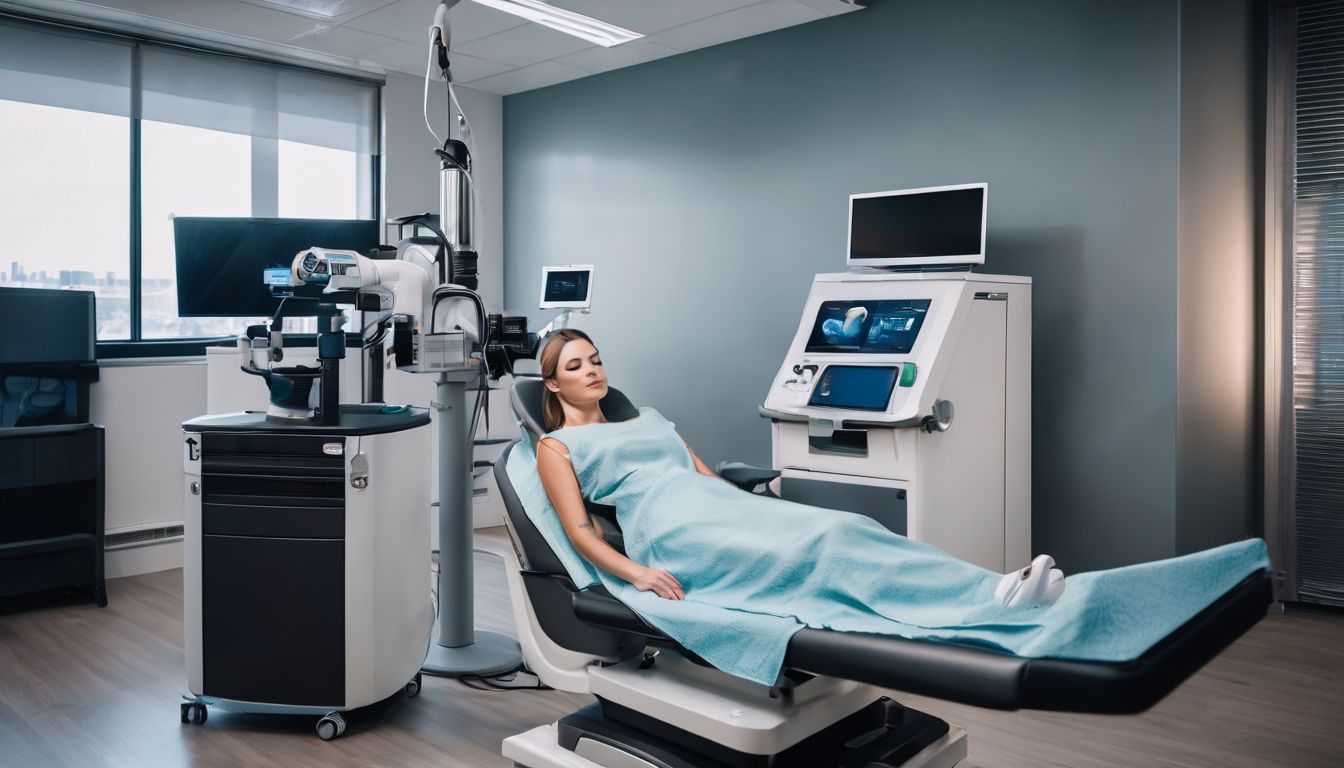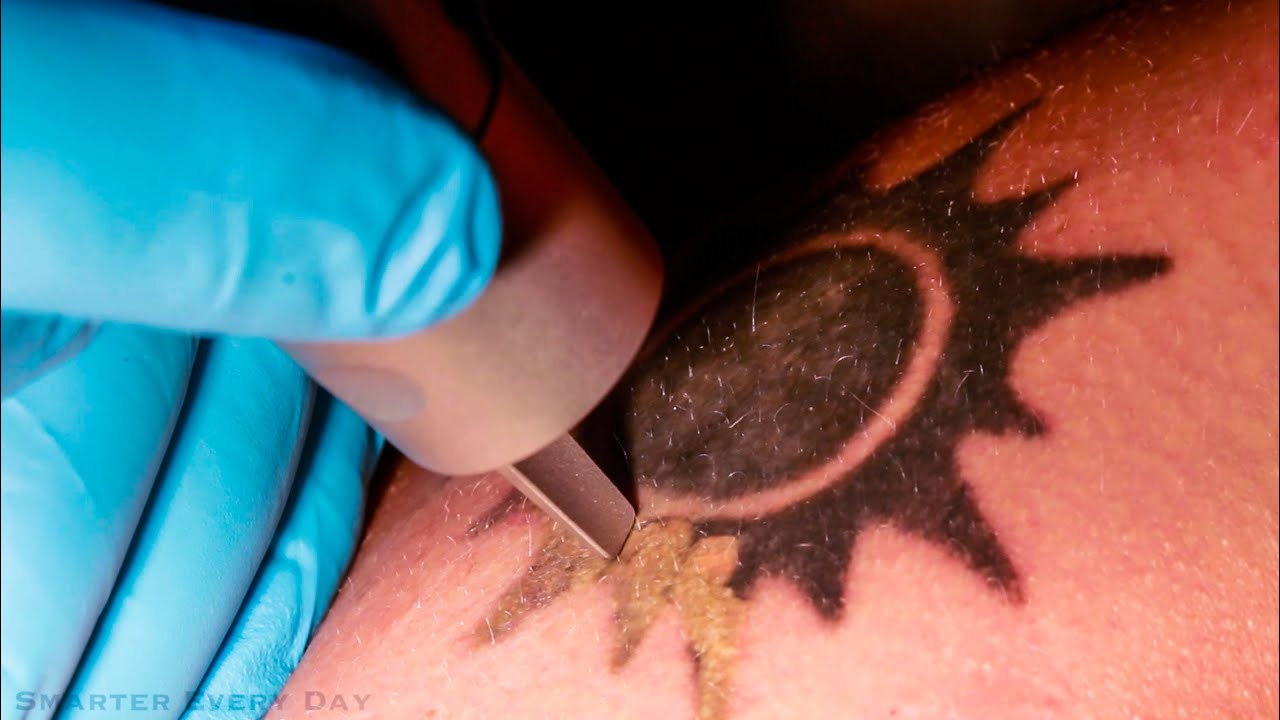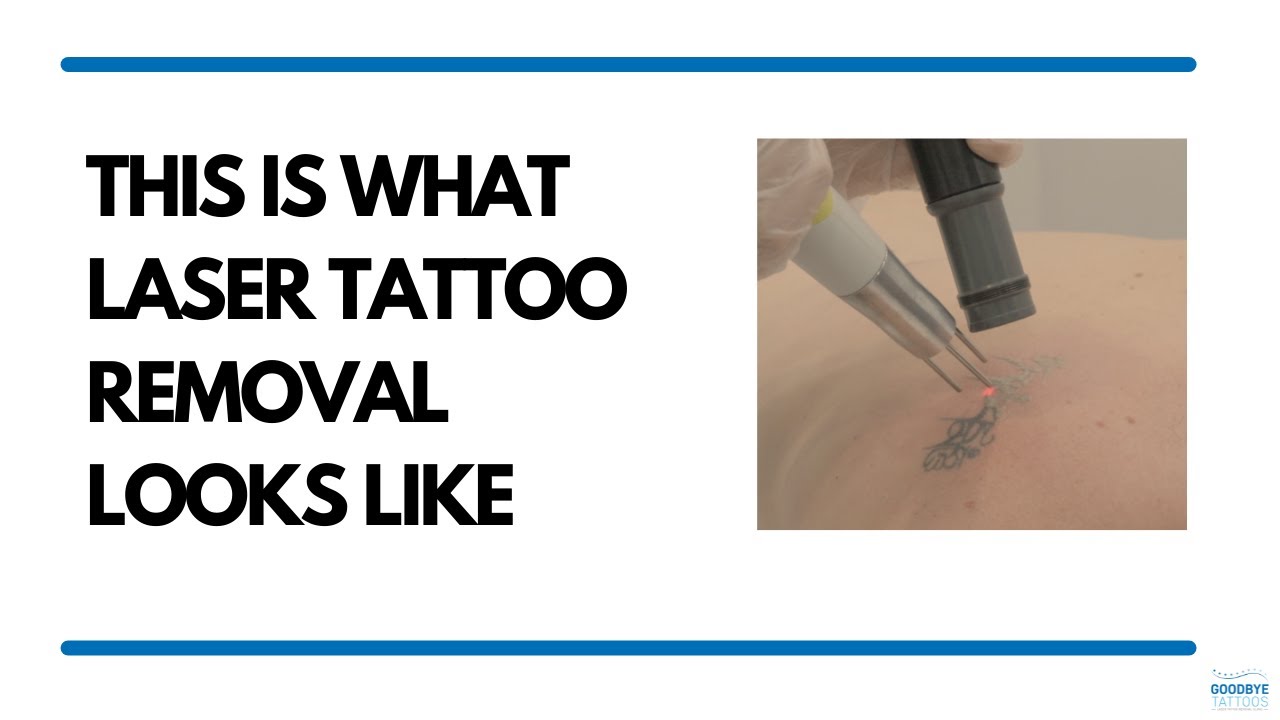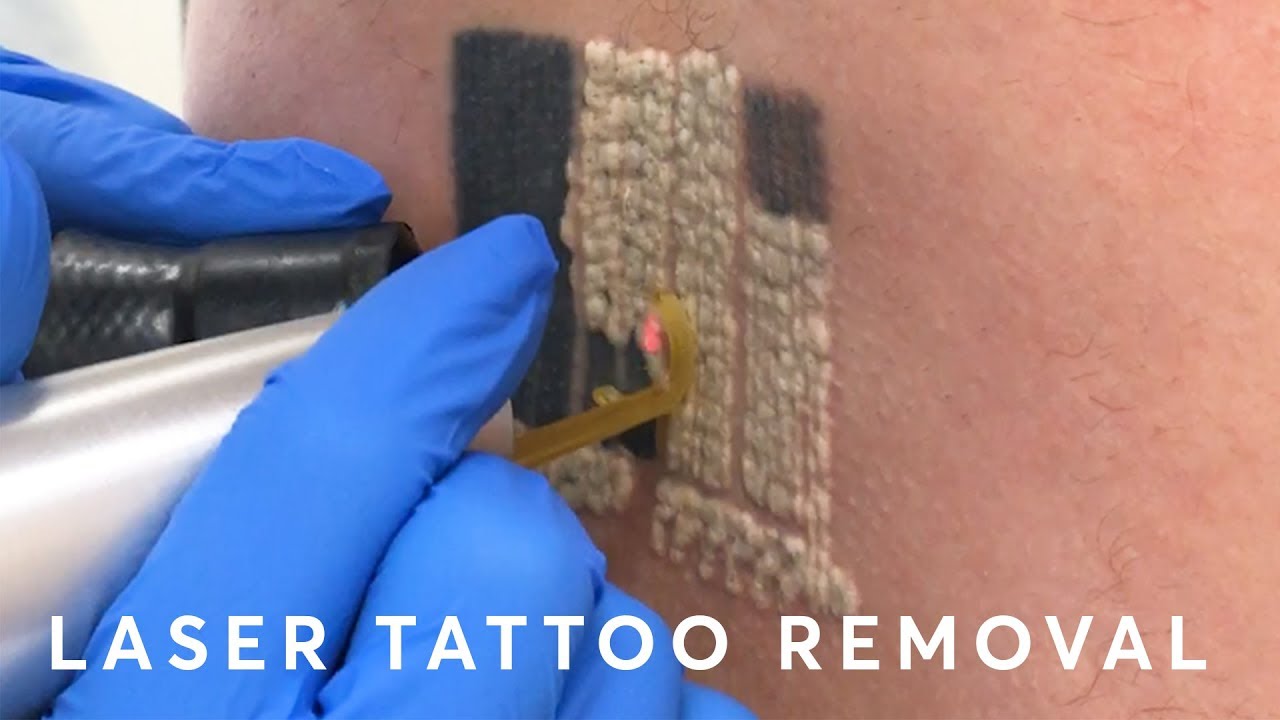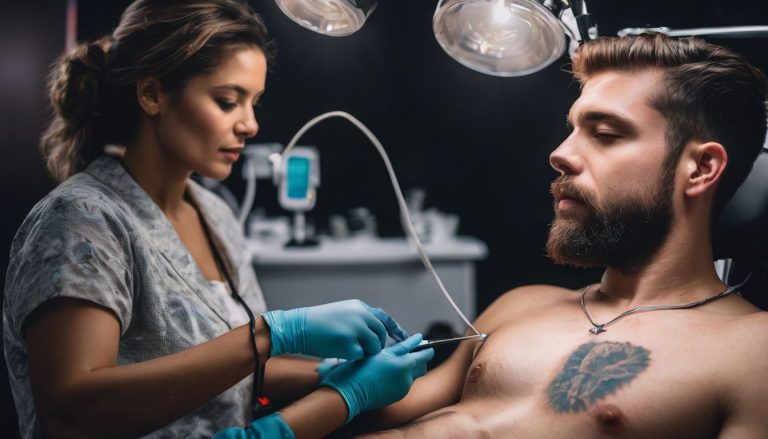The Benefits and Risks of Laser Tattoo Removal: A Comprehensive Guide
Create your own unique tattoos and art for your home
Regretting that permanent tattoo from your past? Laser tattoo removal can offer a second chance for your skin. This guide will navigate you through the ins and outs of ditching unwanted ink safely and effectively.
Read on to find out if this is the solution you’ve been searching for!
Key Takeaways
- Laser tattoo removal effectively targets and removes unwanted tattoos by breaking down ink particles, with results dependent on factors like tattoo size, color, and depth of pigment.
- The procedure is less invasive than alternative methods, offering minimal downtime and fewer side effects while being able to specifically target different colors within a tattoo.
- While the benefits are significant, potential risks include pain and discomfort during treatment, the possibility of scarring, and the risk of infection post-procedure. It’s crucial to carefully weigh these factors before undergoing laser tattoo removal.
Understanding Laser Tattoo Removal
Laser tattoo removal is an advanced procedure that uses focused light beams to break down the ink particles in a tattoo. This process allows the body’s immune system to gradually eliminate the pigments, resulting in the fading and eventual disappearance of the tattoo.
What is laser tattoo removal?
Laser tattoo removal is a medical procedure that uses intense laser beams to break down the ink in tattoos. These high-powered lasers specifically target the pigment in the tattoo, leaving surrounding skin largely unaffected.
During treatment, short pulses of light penetrate the skin and are absorbed by the ink particles. This energy causes the ink to fragment into smaller pieces which are then naturally eliminated by your body’s immune system.
Doctors use different types of lasers based on the colors of the tattoo, as some pigments respond best to certain wavelengths of light. Patients may need multiple sessions for complete removal, with healing time required between each session.
While this method can effectively fade or remove tattoos, it’s important that a trained healthcare professional carries out the procedure to minimize risks such as infection and scarring.
Moving from what laser tattoo removal entails, let’s delve into how this powerful tool actually gets rid of unwanted ink from your skin.
How does it work?
Laser tattoo removal works by using high-powered lasers to break up and eliminate ink particles embedded in the skin. The laser emits intense light energy that is absorbed by the pigment of the tattoo, causing it to fragment into smaller particles.
Over time, the body’s immune system naturally processes and eliminates these tiny ink fragments, gradually fading the tattoo. It typically takes multiple sessions for complete removal due to the gradual breakdown and absorption process.
The procedure poses some risks such as pain, potential scarring, infection, and side effects like blistering or swelling. However, when performed by a skilled professional under proper conditions with informed consent from both parties regarding associated risks and benefits, laser tattoo removal is generally considered safe.
The Benefits of Laser Tattoo Removal
Laser tattoo removal offers effective and targeted removal of tattoos, with less invasive procedures and minimal downtime. It can also specifically target different colors in the tattoo for more comprehensive removal.
Effective in removing tattoos
Laser tattoo removal is highly effective in eliminating unwanted tattoos by breaking down the ink particles in the skin. This process targets the pigments, gradually fading and removing the tattoo over multiple sessions, with results dependent on factors such as tattoo size, color, and depth of pigment.
The procedure’s effectiveness lies in its ability to specifically target different colors and effectively remove even stubborn or intricate designs.
The benefits of laser tattoo removal also extend to its versatility in addressing a wide range of tattoos, including those done by amateur artists or professionals. Additionally, unlike other invasive methods like dermabrasion or surgical excision, laser treatment offers a less invasive approach with minimal downtime for recovery while still achieving significant progress in gradually erasing tattoos.
Less invasive than other methods
Compared to other tattoo removal methods, laser tattoo removal is less invasive. This procedure utilizes high-powered lasers to break down ink particles in the skin, offering a more targeted approach that minimizes damage to surrounding tissue.
Additionally, with minimal downtime and fewer side effects than traditional methods such as dermabrasion or surgical excision, laser tattoo removal presents itself as a relatively safer option for those seeking permanent ink removal.
Laser tattoo removal is significantly less invasive compared to alternatives like dermabrasion or surgical procedures. It targets only the inked areas without harming the surrounding skin, resulting in reduced discomfort and quicker recovery times for individuals undergoing the process.
Minimal downtime
Unlike other tattoo removal methods, laser tattoo removal offers minimal downtime. After the procedure, patients can resume their usual activities without significant interruptions to their daily routine.
This is a major advantage for individuals with busy schedules or those who cannot afford extended recovery periods. Additionally, the quick recovery time allows for multiple treatment sessions to be scheduled more conveniently, ensuring efficient progress in removing unwanted tattoos.
Furthermore, the minimal downtime associated with laser tattoo removal contributes to its appeal as a less disruptive option compared to surgical procedures or other aggressive treatments.
Can target specific colors
Unlike the minimal downtime associated with laser tattoo removal, one of its significant benefits is the ability to target specific colors. This is particularly advantageous for tattoos that contain multiple colors or are predominantly made up of pigments that are typically challenging to remove, such as red and yellow.
Laser technology has advanced to a point where different wavelengths can effectively target a range of colors, allowing for more comprehensive and successful removal outcomes.
Laser tattoo removal utilizes specific light wavelengths that correspond to different ink colors. By adjusting the wavelength used during treatment sessions, healthcare professionals can effectively break down various ink pigments, providing more targeted and precise removal results.
The Risks of Laser Tattoo Removal
Potential risks include pain and discomfort during the procedure, the possibility of scarring, and the risk of infection. To learn more about these risks and how to mitigate them, keep reading!
Pain and discomfort
Pain and discomfort are common during laser tattoo removal due to the high-powered lasers breaking down ink particles in the skin. The process can cause a stinging or burning sensation, although it is generally tolerable for most individuals.
Mild swelling and redness around the treated area are also typical after the procedure, lasting for a few days before subsiding.
Although there is minimal downtime associated with laser tattoo removal, some individuals may experience discomfort during the recovery period as their skin heals. Following proper aftercare instructions provided by your healthcare professional can help alleviate any pain or discomfort and minimize potential side effects such as blistering or scabbing.
Potential for scarring
Laser tattoo removal carries the potential for scarring, which is a risk to consider before undergoing the procedure. The high-powered lasers used in the process can cause damage to the skin, leading to varying degrees of scarring.
It’s essential for individuals seeking tattoo removal to be aware of this possibility and discuss it thoroughly with their healthcare provider. However, it’s important to note that scarring is not guaranteed and can be minimized by following proper aftercare instructions and choosing a reputable doctor.
The risk of scarring should be carefully weighed against the desire to remove a tattoo, and individuals should ensure they are fully informed about all potential outcomes before proceeding with laser tattoo removal.
Infection
While potential for scarring is a concern with laser tattoo removal, another risk to be mindful of is the potential for infection. Despite being minimal, there is still a possibility that the skin may become infected following the procedure.
It’s crucial for patients to follow all aftercare instructions diligently to minimize this risk. Keeping the treated area clean and applying any prescribed ointments can help prevent infection and promote proper healing.
Additionally, promptly seeking medical attention if there are any signs of infection such as increased redness, swelling, or discharge is essential in mitigating further complications.
Finding a Reputable Doctor
Finding a reputable doctor for laser tattoo removal is crucial. It’s important to schedule a consultation, do thorough research, and ask the right questions before undergoing the procedure.
Importance of a consultation
Before undergoing laser tattoo removal, it is crucial to have a consultation with a qualified healthcare professional. During the consultation, the doctor will assess your skin type, the tattoo itself, and discuss potential risks and benefits of the procedure.
This allows for informed consent and ensures that you fully understand what to expect during and after treatment. Moreover, the consultation provides an opportunity to ask any questions or address concerns you may have about the process.
Consultations are essential as they allow healthcare professionals to evaluate whether laser tattoo removal is suitable for you based on your medical history and current health status.
It also gives you a chance to understand the aftercare required post-treatment before proceeding with this transformative procedure.
Do your research
Before undergoing laser tattoo removal, it is crucial to conduct thorough research. Look for reputable clinics and healthcare professionals with extensive experience in performing this procedure.
Consider the risks and benefits carefully based on your skin type, tattoo size, and ink colors. Investigate the different types of lasers used for tattoo removal and their effectiveness in treating specific pigments.
Gather information about aftercare requirements and potential side effects to ensure that you are fully prepared for the process. Understanding these factors will help you make an informed decision about whether laser tattoo removal is right for you.
Remember to seek out unbiased sources such as medical journals, professional associations, or testimonials from individuals who have undergone similar procedures. Furthermore, consult multiple doctors or specialists to get a variety of perspectives and treatment options before making a choice.
Questions to ask
When considering laser tattoo removal, it’s important to be well-informed and ask the right questions during your consultation. Here are some important questions to ask:
- What type of laser will be used for the procedure, and how does it work in removing tattoo ink particles from the skin?
- Can I see before and after photos of previous patients who have undergone laser tattoo removal with similar tattoos and skin types?
- What are the potential side effects of the procedure, and how can they be managed or minimized?
- How many sessions will I likely need to achieve the desired results, and what is the interval between each session?
- Are there any specific aftercare instructions I should follow to ensure optimal healing and minimize risks of complications?
- What is the likelihood of complete removal versus lightening or fading of the tattoo, considering its size, colors, and depth in the skin?
- Can you provide information about your experience and training in performing laser tattoo removal procedures?
- What are the potential risks associated with my specific skin type or medical history that may impact the procedure or recovery process?
- Is there a chance of scarring or pigment changes following laser tattoo removal, especially for tattoos located on certain areas of my body?
Aftercare and Recovery
Proper aftercare is crucial for the healing process after laser tattoo removal. This section will cover how to care for your skin post-treatment, potential side effects, and steps to combat any complications that may arise.
Taking care of your skin after treatment
After laser tattoo removal treatment, it’s crucial to care for your skin to aid in the healing process and reduce the risk of complications. Here are some important steps to take for post-treatment care:
- Keep the treated area clean and dry to prevent infection.
- Apply a recommended ointment or moisturizer as advised by your healthcare professional to promote healing and minimize scarring.
- Protect the treated skin from sun exposure by covering it or using a broad-spectrum sunscreen with SPF 30 or higher.
- Avoid picking at any scabs that may form, as this can lead to scarring and pigment changes.
- Follow any specific aftercare instructions provided by your doctor or dermatologist, including avoiding certain activities or products that could irritate the skin.
- Stay hydrated and maintain a healthy diet to support overall skin recovery.
- Attend scheduled follow – up appointments with your doctor to monitor the healing progress and address any concerns or potential side effects.
Follow-up sessions
– Taking care of your skin after treatment is crucial for successful laser tattoo removal. Follow-up sessions will allow the doctor to monitor your progress and address any concerns or complications that may arise.
It’s important to attend these sessions as scheduled to ensure proper healing and assess any potential side effects.
– Potential side effects, such as blistering, swelling, and scabbing, can be managed effectively during follow-up sessions. Moreover, the clinician can provide guidance on combating complications and adjusting the aftercare routine if necessary.
Potential side effects
Laser tattoo removal may lead to certain side effects. These could include blistering, swelling, and scabbing as the skin heals from the treatment. In some cases, there is also a risk of pigment changes or scarring at the site of the removed tattoo.
Understanding potential side effects is crucial before undergoing laser tattoo removal. It’s important to be aware of these risks in order to make an informed decision about your treatment plan.
Moving on to “Combating complications”..
Combating complications
To minimize potential side effects and complications, it’s crucial to follow post-treatment care instructions diligently. Apply the prescribed creams or ointments to promote healing and reduce the risk of infection.
Keep the treated area clean and dry, and avoid exposing it to direct sunlight to prevent irritation. Additionally, attending all scheduled follow-up sessions is essential for monitoring progress and addressing any emerging concerns promptly.
Seek medical attention if you notice persistent redness, swelling, or signs of infection such as pus or increasing pain. It’s important not to pick at scabs or blisters as doing so can lead to scarring or pigment changes.
Conclusion
In conclusion, laser tattoo removal offers an effective method for removing unwanted tattoos. The benefits include minimal downtime and the ability to target specific colors. However, it’s important to consider potential risks such as pain, scarring, and infection.
Finding a reputable doctor and following proper aftercare are crucial steps in ensuring a successful outcome.
FAQs
1. What is laser tattoo removal?
Laser tattoo removal is a skin treatment where lasers target the pigment in tattoos to break them down, which allows your body to naturally fade and eliminate the ink.
2. Are there benefits to using laser therapy for removing tattoos?
Yes, one of the main benefits of laser therapy for tattoo removal is that it can effectively reduce the appearance of unwanted tattoos without requiring surgical procedures like dermabrasion or tattoo removal surgery.
3. Can removing tattoos at home be as effective as professional laser treatments?
Removing tattoos at home isn’t usually recommended because professional laser treatments are designed specifically for pigment removal and often provide safer, more controlled results compared to do-it-yourself methods.
4. What are some risks associated with laser tattoo removal?
Risks of laser tattoo removal can include skin damage, scarring, infection, changes in skin texture or color and other side effects; however, these risks are generally low when performed by qualified professionals with proper aftercare during the healing process.
5. How long does it take for a tattoo to fade after starting laser treatment?
The fading process varies depending on factors like the age of the tattoo, its location and colors used—laser Tattoo Removal typically requires multiple sessions spaced several weeks apart for full effectiveness; also allowing time between treatments aids in skin rejuvenation and reduces potential side effects.

